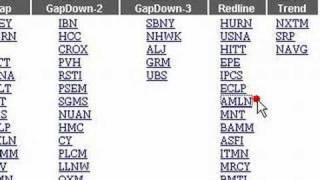This article was written a couple of years ago and I thought I would post it again. It should help you distinguish a “dip” from a “top”.
When a stock has had a “nice run”, the first material sell-off (10%+) gains attention. Traders are trying to access if the highs are finally in, or if this is a great entry point for a long position. I look at both the technicals and fundamentals to help me decide “which camp I’m in”.
From a technical stand point I start with a long term perspective. If the stock has been in a nice tight rally for over six months with a sustainable 45 degree angle to the trend, I’m thinking bullish reversal (buy the dip). The nice grind higher (tight pattern)indicates accumulation and the slope tells me the stock has not gotten ahead of itself. If the trend line has a steep slope, a major pullback can materialize and these do not make good candidates for this trade.
As my technical analysis progresses to an intermediate perspective I look at relative strength within the stock and I compare the last three months to the prior six months. In other words, has the recent move gained steam, lost steam or maintained its grind. If the stock has had a big run I’m suspicious if defined horizontal resistance has been formed. In particular, I don’t like to see a “crowning” formation where the backside is making lower highs. I’m also suspicious if the stock is getting more volatile. The once steady grind higher is now starting to whip around as the stock moves higher. In both cases, the price action is telling me that the sellers and buyers are getting more balanced at that price level.
Eventually my technical analysis will look at the most recent move – the dip. I would rather see a nice orderly decline than a group of big down days. Big down days with opens near the high and closes on the low (re-bodied candles) signal trouble. I also want to see the selling pressure subside as major support levels are tested. If the support is established at higher levels, there is a better the chance for a reversal back up. Remember, in this case, I’m talking about a reversal of the dip and I want to get long. I have found that when a stock drops a little (10% or less) and finds support, the buyers are still “hungry”. The support levels are often 20-Day EMA’s or up trend lines. If the stock goes through a deeper “dip” (20%) it will take longer to reverse and some of the upside momentum has been lost.
Next I look at the fundamental reasons for the sell off. If the stock has dropped because the guidance has been lowered, stay away. That is a material change and the stock may have formed a top. If bad news hit a stock in the group, you need to determine if those same events apply to this stock. I also look at the P/E ratios. I want to know that the selling is not coming from investors who feel the stock is “rich”.
I like situations where a stock has simply pulled back in sympathy with the market. There has not been any news to justify the dip. As soon as the market stops going down, I see the stock finding support. These opportunities tend to reverse quickly. Look for stocks that have reasonable P/E’s and have been in a long-term grind higher. The pullback is relatively shallow and the stock has found early support at a high level.
CMI was a good example. The dip (May 2006) was small, orderly and market related. The long term trend was tight, the P/E were reasonable and the stock quickly recovered. CRM was a bad example. The stock doubled from November (2005) to January (2006), creating a steep trend line. In February (2006) it had a sharp 15% sell off that broke multiple support levels (moving averages, trend lines, horizontal). The stock was trading at a stratospheric P/E and the market was very strong during the stock’s decline.
If you trade a bullish reversal and the support is breached or the stock gets “wild”, step aside and take your loses. The character of the longer-term move may be changing.
If you have any examples you think might “fit”, post a comment and I’ll take a look.









